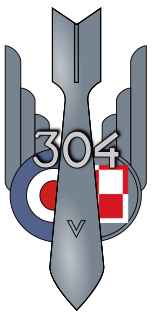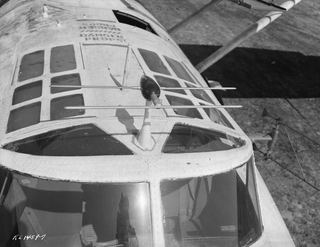
The Leigh Light (L/L) was a British World War II era anti-submarine device used in the Battle of the Atlantic. It was a powerful carbon arc searchlight of 24 inches (610 mm) diameter fitted to a number of the British Royal Air Force's Coastal Command patrol bombers to help them spot surfaced German U-boats at night.

Royal Air Force Chivenor or RAF Chivenor was a Royal Air Force station located on the northern shore of the River Taw estuary, on the north coast of Devon, England. The nearest towns are Barnstaple and Braunton.

The Naxos radar warning receiver was a World War II German countermeasure to S band microwave radar produced by a cavity magnetron. Introduced in September 1943, it replaced Metox, which was incapable of detecting centimetric radar. Two versions were widely used, the FuG 350 Naxos Z that allowed night fighters to home in on H2S radars carried by RAF Bomber Command aircraft, and the FuMB 7 Naxos U for U-boats, offering early warning of the approach of RAF Coastal Command patrol aircraft equipped with ASV Mark III radar. A later model, Naxos ZR, provided warning of the approach of RAF night fighters equipped with AI Mk. VIII radar.

No. 311 (Czechoslovak) Squadron RAF was a Czechoslovak-manned bomber squadron of the Royal Air Force in the Second World War. It was the RAF's only Czechoslovak-manned medium and heavy bomber squadron. It suffered the heaviest losses of any Czechoslovak formation in the RAF. In the Second World War 511 Czechoslovaks serving in Allied air forces were killed. Of these 273 (53%) died while serving with 311 Squadron.
No. 119 Squadron RAF was a squadron of the Royal Air Force, flying with RAF Coastal Command during the Second World War. It was the only RAF unit flying the Short G class and Short C class flying boats.

No. 304 Polish Bomber Squadron was a Polish World War II bomber unit. It fought alongside the Royal Air Force under their operational Command and operated from airfields in the United Kingdom, serving from April 1941 as a bomber unit in RAF Bomber Command, from May 1942 as an anti-submarine unit in RAF Coastal Command and from June 1945 as a transport unit in RAF Transport Command.

No. 461 Squadron was a Royal Australian Air Force maritime patrol squadron during World War II which operated under Royal Air Force control flying in Europe and over the Atlantic. The squadron was formed in 1942 and was disbanded in mid-1945, just after the end of the war in Europe. Personnel were drawn from many countries of the British Empire, although the majority were Australians. Throughout the war, the squadron was credited with destroying a total of six German U-boats, and operated mainly in the Bay of Biscay and Atlantic.

Royal Air Force St. Eval or RAF St. Eval was a Royal Air Force station for the RAF Coastal Command, southwest of Padstow in Cornwall, England, UK. St Eval's primary role was to provide anti-submarine and anti-shipping patrols off the south west coast. Aircraft from the airfield were also used for photographic reconnaissance missions, meteorological flights, convoy patrols, air-sea rescue missions and protection of the airfield from the Luftwaffe.
German submarine U-256 was a Type VIIC U-boat of Nazi Germany's Kriegsmarine during World War II, she also served for a short time as an anti-aircraft submarine under the designation U-flak 2. During her career, U-256 completed five wartime patrols and sank one warship of 1,300 tons.

No. 500 Squadron AAF was a Royal Air Force flying squadron. It was initially formed in 1931 as a Special Reserve squadron and in 1936 became part of the Auxiliary Air Force, at this time based at Manston and Detling.

The Mid-Atlantic gap is a geographical term applied to an undefended area beyond the reach of land-based RAF Coastal Command antisubmarine (A/S) aircraft during the Battle of the Atlantic in the Second World War. It is frequently known as The Black Pit, as well as the Atlantic Gap, Air Gap, Greenland Gap, or just "the Gap". This resulted in heavy merchant shipping losses to U-boats. The gap was eventually closed in May 1943, as growing numbers of VLR Liberators and escort carriers became available, and as basing problems were addressed.
No. 234 Squadron RAF had a long career within the RAF, being operational on flying boats in World War I and on fighter aircraft in World War II. After the war it remained a fighter unit till 1957. In its last incarnation the squadron was in turn Operational Training Unit (OTU), Tactical Weapon Unit (TWU) and part of No. 4 Flying Training School RAF until finally disbanded in 1994.
No. 248 Squadron was a squadron of the Royal Air Force, active immediately after World War I, and again during World War II.

No. 1417 Flight RAF was an independent flight of the Royal Air Force which existed between 1941 and 1993 at various times in a variety of roles. This Flight had probably the most interesting incarnations of all the independent aircraft flights of the Royal Air Force, introducing new technologies and operating complex fast jet aircraft in challenging and austere conditions, from the Arabian Peninsula to Central America.
RAF Coastal Command was a formation within the Royal Air Force (RAF). Founded in 1936, it was to act as the RAF maritime arm, after the Fleet Air Arm became part of the Royal Navy in 1937. Naval aviation was neglected in the inter-war period, 1919–1939, and as a consequence the service did not receive the resources it needed to develop properly or efficiently. This continued until the outbreak of the Second World War, during which it came to prominence. Owing to the Air Ministry's concentration on RAF Fighter Command and RAF Bomber Command, Coastal Command was often referred to as the "Cinderella Service", a phrase first used by the First Lord of the Admiralty at the time A V Alexander.
No. 179 Squadron RAF was a Royal Air Force Squadron that was a maritime patrol/anti-submarine warfare unit in World War II.
German submarine U-415 was a Type VIIC U-boat built for Nazi Germany's Kriegsmarine for service during World War II.

Radar, Air-to-Surface Vessel, Mark II, or ASV Mk. II for short, was an airborne sea-surface search radar developed by the UK's Air Ministry immediately prior to the start of World War II. It was the first aircraft mounted radar of any sort to be used operationally. It was widely used by aircraft of the RAF Coastal Command, Fleet Air Arm and similar groups in the United States and Canada. A version was also developed for small ships, the Royal Navy's Type 286.
Radar, Air-to-Surface Vessel, or ASV radar for short, is a classification used by the Royal Air Force (RAF) to refer to a series of aircraft-mounted radar systems used to scan the surface of the ocean to locate ships and surfaced submarines. The first examples were developed just before the opening of World War II and they have remained a major instrument on patrol aircraft since that time. It is part of the wider surface search radar classification, which includes similar radars in ground and ship mountings.

Radar, Air-to-Surface Vessel, Mark III, or ASV Mk. III for short, was a surface search radar system used by RAF Coastal Command during World War II. It was a slightly modified version of the H2S radar used by RAF Bomber Command, with minor changes to the antenna to make it more useful for the anti-submarine role. It was Coastal Command's primary radar from the spring of 1943 until the end of the war. Several improved versions were introduced, notably the ASV Mark VI, which replaced most Mk. IIIs from 1944 and ASV Mark VII radar, which saw only limited use until the post-war era.













